英语诗歌的格律
- 格式:docx
- 大小:25.26 KB
- 文档页数:6
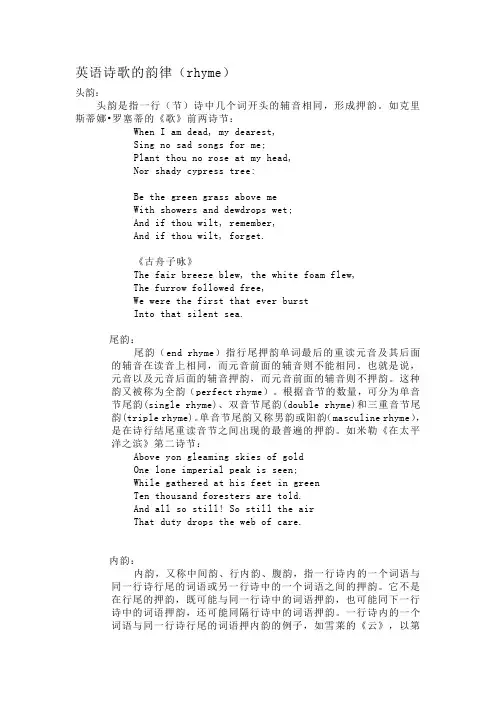
英语诗歌的韵律(rhyme)头韵:头韵是指一行(节)诗中几个词开头的辅音相同,形成押韵。
如克里斯蒂娜•罗塞蒂的《歌》前两诗节:When I am dead, my dearest,Sing no sad songs for me;Plant thou no rose at my head,Nor shady cypress tree:Be the green grass above meWith showers and dewdrops wet;And if thou wilt, remember,And if thou wilt, forget.《古舟子咏》The fair breeze blew, the white foam flew,The furrow followed free,We were the first that ever burstInto that silent sea.尾韵:尾韵(end rhyme)指行尾押韵单词最后的重读元音及其后面的辅音在读音上相同,而元音前面的辅音则不能相同。
也就是说,元音以及元音后面的辅音押韵,而元音前面的辅音则不押韵。
这种韵又被称为全韵(perfect rhyme)。
根据音节的数量,可分为单音节尾韵(single rhyme)、双音节尾韵(double rhyme)和三重音节尾韵(triple rhyme)。
单音节尾韵又称男韵或阳韵(masculine rhyme),是在诗行结尾重读音节之间出现的最普遍的押韵。
如米勒《在太平洋之滨》第二诗节:Above yon gleaming skies of goldOne lone imperial peak is seen;While gathered at his feet in greenTen thousand foresters are told.And all so still! So still the airThat duty drops the web of care.内韵:内韵,又称中间韵、行内韵、腹韵,指一行诗内的一个词语与同一行诗行尾的词语或另一行诗中的一个词语之间的押韵。
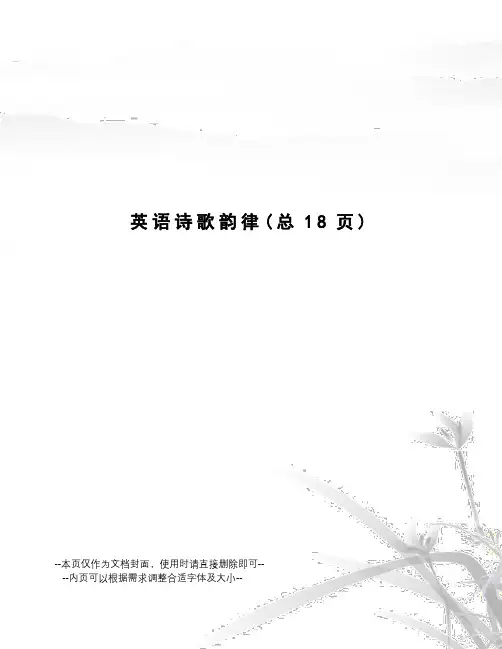
英语诗歌韵律(总18页)--本页仅作为文档封面,使用时请直接删除即可----内页可以根据需求调整合适字体及大小--英语诗歌的韵律(metre)英诗节奏(Rhythm) 构成英诗节奏的基础是韵律(metre)。
在希腊语中,“metre”这个字是“尺度(标谁)”的意思。
英诗就是根据诗行中的音节和重读节奏作为“尺度(标准)”来计算韵律的。
英诗的特点之一是与其他文体不同的排列格式。
各诗行不达到每页页边,每行开始词首大写。
几行成为一节(stanza),不分段落。
各行都要讲究一定的音节数量,行末押韵或不押韵,交错排列。
……音节重读(stressed),非重读(unstressed)。
……这就是一种正规的重读形式,在诗歌中即体现为韵律。
研究诗歌韵律规则的科学叫作韵律学(Prosody)。
1.音步(Foot):英诗中这种重读与非重读音节的特殊性组合叫作音步。
一个音步的音节数量可能为两个或三个音节,但不能少于两个或多于三个音节,而且其中只有一个必须重读。
分析英诗的格律就是将它划分成音步,并区分出是何种音步以及计算音步的数量。
这种音步划分叫scansion。
根据一首英诗组成的音步数量,每一诗行一个音步称“单音步”(monometer);每一诗行有两个音步的,称“双音步”(dimeter);含有三个音步的,称“三音步”(trimeter);此外还有四音步(tetrameter)、五音步、(pentameter)、六音步(hexameter)、七音步(heptameter)、八音步(octometer)。
Is this | a fast, | to keepThe lard | or leanAnd clean (Herrick)2.韵律(Metre):英诗的韵律是依据音步包含音节的数量及重读音节的位置而加以区分的。
传统英诗的音步有六种:即:抑扬格(Lambus)、扬抑格(Trochee)、抑抑扬格(Anapaest)、扬抑抑格(Dactyl)及:扬抑抑格(Dactyl)及抑扬抑格(Amphibrach):“⌒”非重读音节;“/”重读音节。
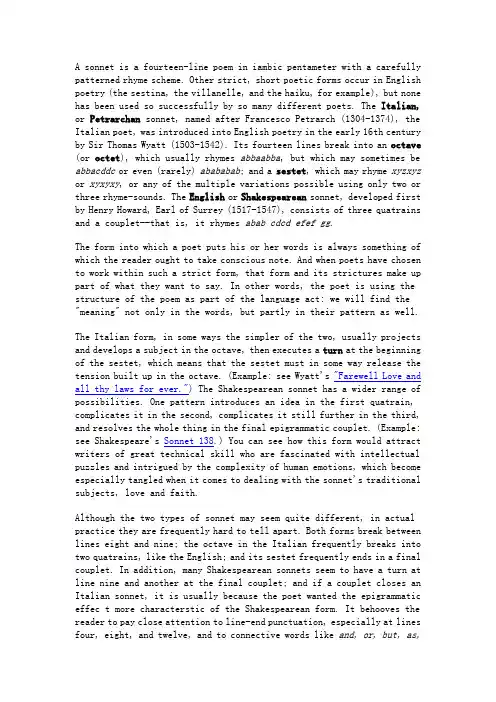
A sonnet is a fourteen-line poem in iambic pentameter with a carefully patterned rhyme scheme. Other strict, short poetic forms occur in English poetry (the sestina, the villanelle, and the haiku, for example), but none has been used so successfully by so many different poets. The Italian, or Petrarchan sonnet, named after Francesco Petrarch (1304-1374), the Italian poet, was introduced into English poetry in the early 16th century by Sir Thomas Wyatt (1503-1542). Its fourteen lines break into an octave (or octet), which usually rhymes abbaabba, but which may sometimes be abbacddc or even (rarely) abababab; and a sestet, which may rhyme xyzxyz or xyxyxy, or any of the multiple variations possible using only two or three rhyme-sounds. The English or Shakespearean sonnet, developed first by Henry Howard, Earl of Surrey (1517-1547), consists of three quatrains and a couplet--that is, it rhymes abab cdcd efef gg.The form into which a poet puts his or her words is always something of which the reader ought to take conscious note. And when poets have chosen to work within such a strict form, that form and its strictures make up part of what they want to say. In other words, the poet is using the structure of the poem as part of the language act: we will find the "meaning" not only in the words, but partly in their pattern as well.The Italian form, in some ways the simpler of the two, usually projects and develops a subject in the octave, then executes a turn at the beginning of the sestet, which means that the sestet must in some way release the tension built up in the octave. (Example: see Wyatt's "Farewell Love and all thy laws for ever.") The Shakespearean sonnet has a wider range of possibilities. One pattern introduces an idea in the first quatrain, complicates it in the second, complicates it still further in the third, and resolves the whole thing in the final epigrammatic couplet. (Example: see Shakespeare's Sonnet 138.) You can see how this form would attract writers of great technical skill who are fascinated with intellectual puzzles and intrigued by the complexity of human emotions, which become especially tangled when it comes to dealing with the sonnet's traditional subjects, love and faith.Although the two types of sonnet may seem quite different, in actual practice they are frequently hard to tell apart. Both forms break between lines eight and nine; the octave in the Italian frequently breaks into two quatrains, like the English; and its sestet frequently ends in a final couplet. In addition, many Shakespearean sonnets seem to have a turn at line nine and another at the final couplet; and if a couplet closes an Italian sonnet, it is usually because the poet wanted the epigrammatic effec t more characterstic of the Shakespearean form. It behooves the reader to pay close attention to line-end punctuation, especially at lines four, eight, and twelve, and to connective words like and, or, but, as,so, if, then, when,or which at the beginnings of lines (especially lines five, nine, and thirteen).十四行诗,又译“商籁体”,为意大利文sonetto,英文Sonnet、法文sonnet 的音译。

meter格律
(最新版)
目录
1.什么是 meter 格律
2.meter 格律的作用
3.meter 格律的发展历程
4.meter 格律在现代的应用
5.结论
正文
1.什么是 meter 格律
Meter 格律,又称为韵律规则,是一种用于指导诗歌、歌词等文学作品中音节、音韵、节奏和抑扬顿挫的规范。
简单来说,它是一种音乐性的语言规则,用于创造优美的文学声响效果。
2.meter 格律的作用
Meter 格律在文学创作中有着至关重要的作用。
首先,它可以确保文学作品的音韵美感,让读者在阅读的过程中感受到和谐的节奏。
其次,它可以帮助作者更好地表达情感,增强文学作品的表现力。
最后,meter 格律可以提高文学作品的艺术价值,使其具有独特的韵律美感。
3.meter 格律的发展历程
Meter 格律的发展历程可以追溯到古代希腊和罗马时期。
在这个时期,史诗和戏剧等文学作品的创作已经开始运用韵律规则。
随着文学的发展,meter 格律逐渐演变为更为复杂和精细的系统,如英语诗歌中的抑扬格律、五言律诗等。
4.meter 格律在现代的应用
尽管现代社会,文学作品的创作形式已经发生了很大变化,但 meter 格律依然在现代文学创作中有着广泛的应用。
许多现代诗人和歌词作者仍然遵循一定的韵律规则来创作作品,以期达到更好的艺术效果。
同时,meter 格律也是文学研究、文学批评等领域的重要课题。
5.结论
总之,meter 格律是一种具有悠久历史和重要意义的文学规范。
它不仅关乎文学作品的音韵美感,还关乎作者的情感表达和作品的艺术价值。
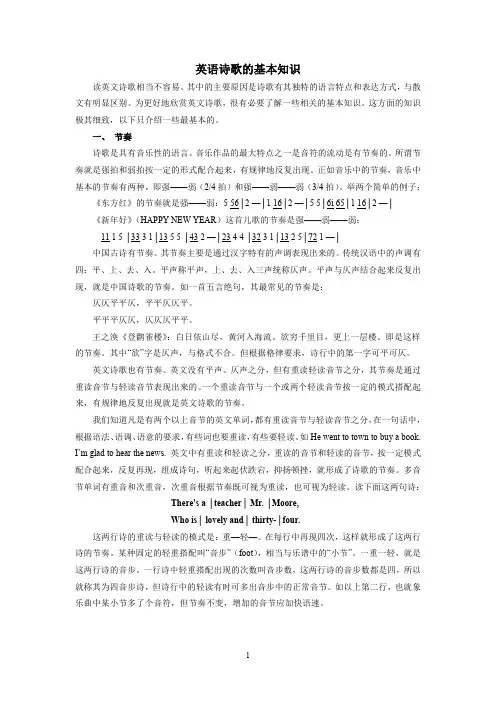
英语诗歌的基本知识读英文诗歌相当不容易。
其中的主要原因是诗歌有其独特的语言特点和表达方式,与散文有明显区别。
为更好地欣赏英文诗歌,很有必要了解一些相关的基本知识。
这方面的知识极其细致,以下只介绍一些最基本的。
一、节奏诗歌是具有音乐性的语言。
音乐作品的最大特点之一是音符的流动是有节奏的。
所谓节奏就是强拍和弱拍按一定的形式配合起来,有规律地反复出现。
正如音乐中的节奏,音乐中基本的节奏有两种,即强——弱(2/4拍)和强——弱——弱(3/4拍)。
举两个简单的例子:《东方红》的节奏就是强——弱:556│2—│116│2—│55│6i65│116│2—│《新年好》(HAPPY NEW YEAR)这首儿歌的节奏是强——弱——弱:1115│3331│1355│432—│2344│3231│1325│721—│中国古诗有节奏。
其节奏主要是通过汉字特有的声调表现出来的。
传统汉语中的声调有四:平、上、去、入。
平声称平声,上、去、入三声统称仄声。
平声与仄声结合起来反复出现,就是中国诗歌的节奏。
如一首五言绝句,其最常见的节奏是:仄仄平平仄,平平仄仄平。
平平平仄仄,仄仄仄平平。
王之涣《登鹳雀楼》:白日依山尽,黄河入海流。
欲穷千里目,更上一层楼。
即是这样的节奏。
其中“欲”字是仄声,与格式不合。
但根据格律要求,诗行中的第一字可平可仄。
英文诗歌也有节奏。
英文没有平声、仄声之分,但有重读轻读音节之分,其节奏是通过重读音节与轻读音节表现出来的。
一个重读音节与一个或两个轻读音节按一定的模式搭配起来,有规律地反复出现就是英文诗歌的节奏。
我们知道凡是有两个以上音节的英文单词,都有重读音节与轻读音节之分,在一句话中,根据语法、语调、语意的要求,有些词也要重读,有些要轻读。
如He went to town to buy a book. I’m glad to hear the news.英文中有重读和轻读之分,重读的音节和轻读的音节,按一定模式配合起来,反复再现,组成诗句,听起来起伏跌宕,抑扬顿挫,就形成了诗歌的节奏。
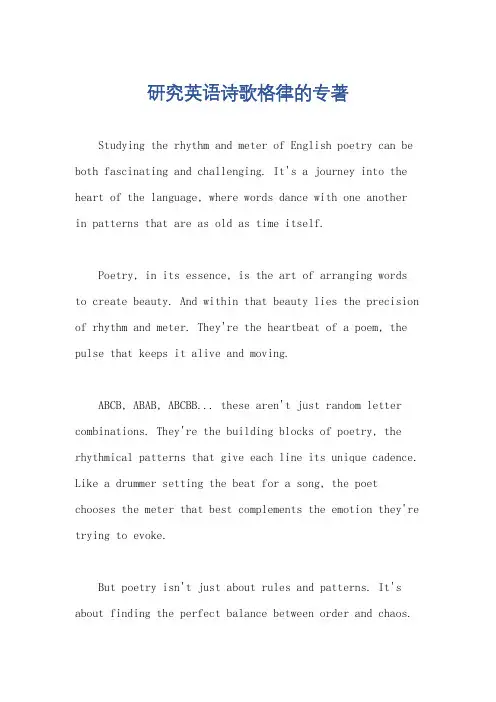
研究英语诗歌格律的专著Studying the rhythm and meter of English poetry can be both fascinating and challenging. It's a journey into the heart of the language, where words dance with one another in patterns that are as old as time itself.Poetry, in its essence, is the art of arranging words to create beauty. And within that beauty lies the precision of rhythm and meter. They're the heartbeat of a poem, the pulse that keeps it alive and moving.ABCB, ABAB, ABCBB... these aren't just random letter combinations. They're the building blocks of poetry, the rhythmical patterns that give each line its unique cadence. Like a drummer setting the beat for a song, the poet chooses the meter that best complements the emotion they're trying to evoke.But poetry isn't just about rules and patterns. It's about finding the perfect balance between order and chaos.Sometimes, a poet might break the rules intentionally, just to surprise the reader or create a new kind of harmony.It's this experimentation that keeps poetry fresh and exciting.And don't forget the role of sound in poetry. The way words sound together can create a mood or atmosphere that's almost tangible. Alliteration, assonance, consonance... these are the tools poets use to play with sound, to create melodies that resonate deep within us.Finally, poetry is about expression. It's a way for us to communicate our innermost thoughts and feelings in a.。
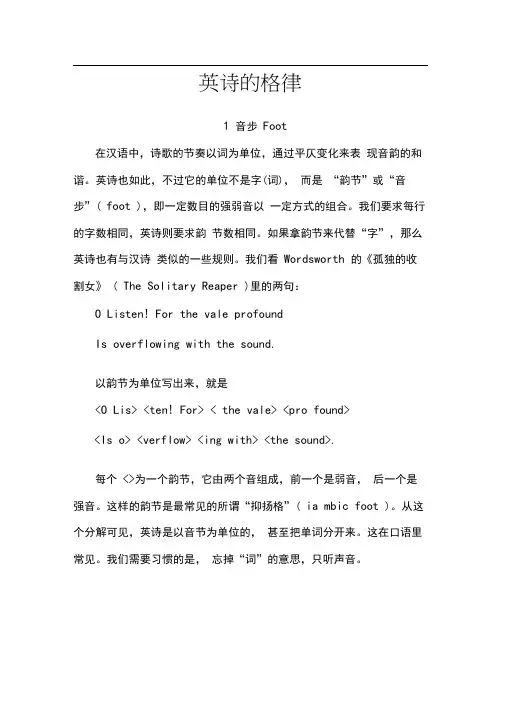
英诗的格律1 音步Foot在汉语中,诗歌的节奏以词为单位,通过平仄变化来表现音韵的和谐。
英诗也如此,不过它的单位不是字(词),而是“韵节”或“音步”( foot ),即一定数目的强弱音以一定方式的组合。
我们要求每行的字数相同,英诗则要求韵节数相同。
如果拿韵节来代替“字”,那么英诗也有与汉诗类似的一些规则。
我们看Wordsworth 的《孤独的收割女》 ( The Solitary Reaper )里的两句:O Listen! For the vale profoundIs overflowing with the sound.以韵节为单位写出来,就是<O Lis> <ten! For> < the vale> <pro found><Is o> <verflow> <ing with> <the sound>.每个<>为一个韵节,它由两个音组成,前一个是弱音,后一个是强音。
这样的韵节是最常见的所谓“抑扬格”( ia mbic foot )。
从这个分解可见,英诗是以音节为单位的,甚至把单词分开来。
这在口语里常见。
我们需要习惯的是,忘掉“词”的意思,只听声音。
有了抑扬格的例子,就不难理解所有其他形式了,据说古代有20 多种呢。
不过,现代英诗最通行的只有四种,除了抑扬格外,还有扬抑格( Trochaic foot )、抑抑扬格( A napaestic foot )、扬抑抑格( Dactylic foot ):若干韵节构成一行诗句,它的长度叫meter 。
最短的当然只有一个韵节 (monometer), 最长的有八个 (OCtameter ),而最流行的是五个,即所谓的“五音步”( pentameter ),而且常常是抑扬格的,这就是iambiC pentameter 。
一音步( monometer ) 二音步( dimeter ) 三音步( trimeter ) 四音步( tetrameter ) 五音步( pentameter ) 六音步( hexameter ) 七音步( heptameter ) 八音步( oCtameter )借音步来说,我们的七律是四音步的,如“无边落木萧萧下”,“春蚕到死丝方尽”等。
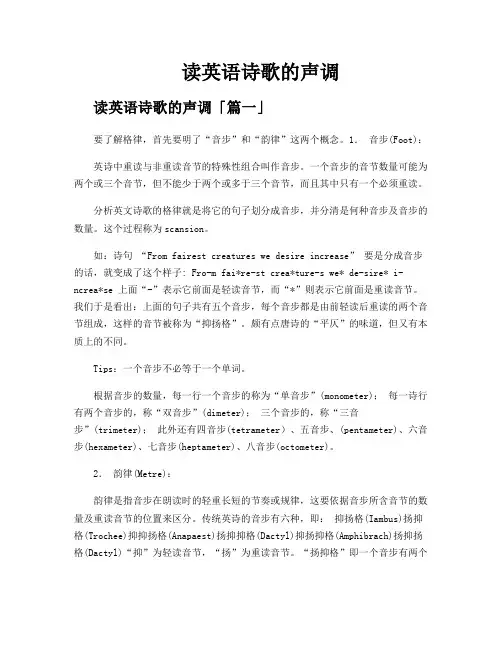
读英语诗歌的声调读英语诗歌的声调「篇一」要了解格律,首先要明了“音步”和“韵律”这两个概念。
1.音步(Foot):英诗中重读与非重读音节的特殊性组合叫作音步。
一个音步的音节数量可能为两个或三个音节,但不能少于两个或多于三个音节,而且其中只有一个必须重读。
分析英文诗歌的格律就是将它的句子划分成音步,并分清是何种音步及音步的数量。
这个过程称为scansion。
如:诗句“From fairest creatures we desire increase” 要是分成音步的话,就变成了这个样子: Fro-m fai*re-st crea*ture-s we* de-sire* i-ncrea*se 上面“-”表示它前面是轻读音节,而“*”则表示它前面是重读音节。
我们于是看出:上面的句子共有五个音步,每个音步都是由前轻读后重读的两个音节组成,这样的音节被称为“抑扬格”。
颇有点唐诗的“平仄”的味道,但又有本质上的不同。
Tips:一个音步不必等于一个单词。
根据音步的数量,每一行一个音步的称为“单音步”(monometer);每一诗行有两个音步的,称“双音步”(dimeter);三个音步的,称“三音步”(trimeter);此外还有四音步(tetrameter)、五音步、(pentameter)、六音步(hexameter)、七音步(heptameter)、八音步(octometer)。
2.韵律(Metre):韵律是指音步在朗读时的轻重长短的节奏或规律,这要依据音步所含音节的数量及重读音节的位置来区分。
传统英诗的音步有六种,即:抑扬格(Iambus)扬抑格(Trochee)抑抑扬格(Anapaest)扬抑抑格(Dactyl)抑扬抑格(Amphibrach)扬抑扬格(Dactyl)“抑”为轻读音节,“扬”为重读音节。
“扬抑格”即一个音步有两个音节,前面的音节重读,后面的轻读。
同理,“扬抑扬格”即一个音步有三个音节,最前的音节重读,中轻读,后重读。
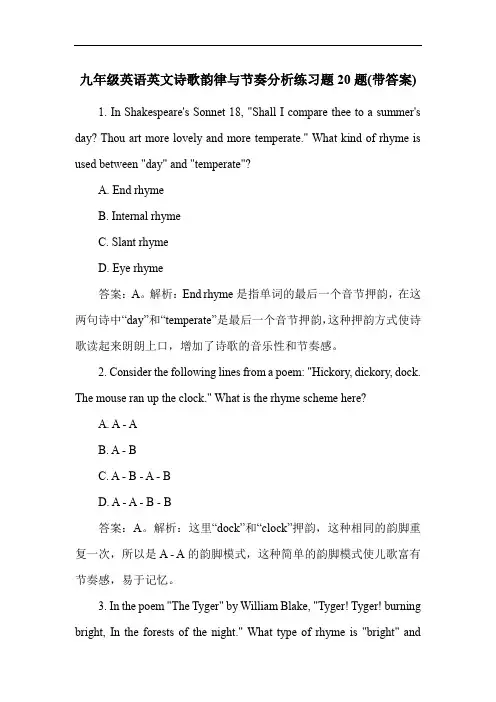
九年级英语英文诗歌韵律与节奏分析练习题20题(带答案)1. In Shakespeare's Sonnet 18, "Shall I compare thee to a summer's day? Thou art more lovely and more temperate." What kind of rhyme is used between "day" and "temperate"?A. End rhymeB. Internal rhymeC. Slant rhymeD. Eye rhyme答案:A。
解析:End rhyme是指单词的最后一个音节押韵,在这两句诗中“day”和“temperate”是最后一个音节押韵,这种押韵方式使诗歌读起来朗朗上口,增加了诗歌的音乐性和节奏感。
2. Consider the following lines from a poem: "Hickory, dickory, dock. The mouse ran up the clock." What is the rhyme scheme here?A. A - AB. A - BC. A - B - A - BD. A - A - B - B答案:A。
解析:这里“dock”和“clock”押韵,这种相同的韵脚重复一次,所以是A - A的韵脚模式,这种简单的韵脚模式使儿歌富有节奏感,易于记忆。
3. In the poem "The Tyger" by William Blake, "Tyger! Tyger! burning bright, In the forests of the night." What type of rhyme is "bright" and"night"?A. Masculine rhymeB. Feminine rhymeC. Triple rhymeD. Monorhyme答案:A。
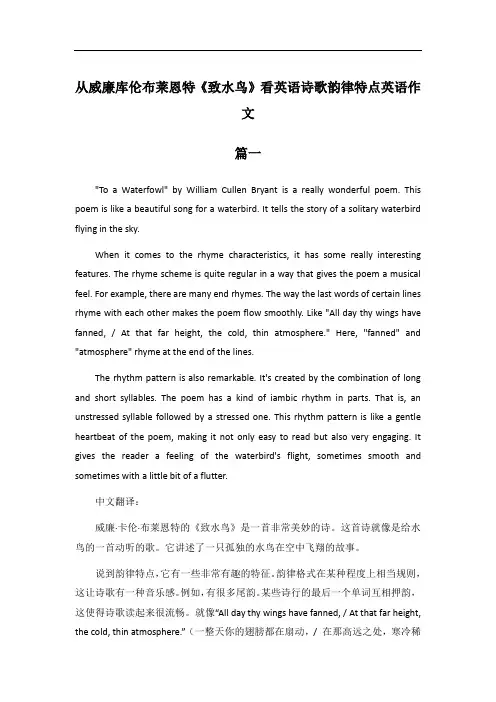
从威廉库伦布莱恩特《致水鸟》看英语诗歌韵律特点英语作文篇一"To a Waterfowl" by William Cullen Bryant is a really wonderful poem. This poem is like a beautiful song for a waterbird. It tells the story of a solitary waterbird flying in the sky.When it comes to the rhyme characteristics, it has some really interesting features. The rhyme scheme is quite regular in a way that gives the poem a musical feel. For example, there are many end rhymes. The way the last words of certain lines rhyme with each other makes the poem flow smoothly. Like "All day thy wings have fanned, / At that far height, the cold, thin atmosphere." Here, "fanned" and "atmosphere" rhyme at the end of the lines.The rhythm pattern is also remarkable. It's created by the combination of long and short syllables. The poem has a kind of iambic rhythm in parts. That is, an unstressed syllable followed by a stressed one. This rhythm pattern is like a gentle heartbeat of the poem, making it not only easy to read but also very engaging. It gives the reader a feeling of the waterbird's flight, sometimes smooth and sometimes with a little bit of a flutter.中文翻译:威廉·卡伦·布莱恩特的《致水鸟》是一首非常美妙的诗。
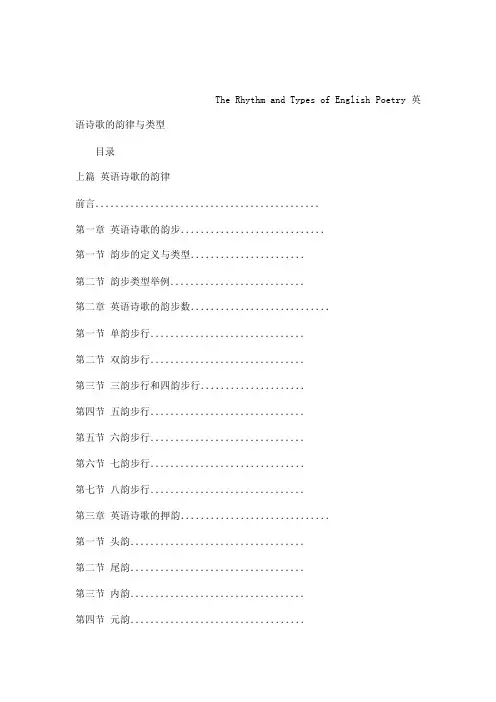
The Rhythm and Types of English Poetry英语诗歌的韵律与类型目录上篇英语诗歌的韵律前言.............................................第一章英语诗歌的韵步.............................第一节韵步的定义与类型.......................第二节韵步类型举例...........................第二章英语诗歌的韵步数............................第一节单韵步行...............................第二节双韵步行...............................第三节三韵步行和四韵步行.....................第四节五韵步行...............................第五节六韵步行...............................第六节七韵步行...............................第七节八韵步行...............................第三章英语诗歌的押韵..............................第一节头韵...................................第二节尾韵...................................第三节内韵...................................第四节元韵...................................第六节目韵...................................第四章英语诗歌的基本押韵格式......................第一节基本押韵格式...........................第二节基本押韵格式的组合使用.................第五章十四行诗的押韵格式.......................第一节彼特拉克体..........................第二节莎士比亚体..........................第三节斯宾塞体............................第六章诗行与韵律...............................第一节结句行..............................第二节连续行..............................第三节音节增减............................第四节句式倒装............................第七章五行打油诗与短回旋诗.....................第一节五行打油诗..........................第二节短回旋诗............................第八章素体诗与自由诗...........................第一节素体诗..............................第二节自由诗..............................下篇英语诗歌的类型第九章叙事诗...................................第二节歌谣.................................第三节戏剧诗...............................第四节故事诗...............................第十章抒情诗...................................第一节颂诗..................................第二节挽歌..................................第三节婚庆曲................................第四节歌..................................第五节田园短诗............................第六节田园牧歌............................第七节爱情小诗............................第八节哲理诗..............................第九节宗教诗..............................第十节赞美诗..............................第十一节墓志铭.............................第十二节收场白............................第十一章融入中国文化的英语诗歌.................前言《英语诗歌的韵律与类型》是出于教学的需要而编写的诗歌的最大特征是韵律要欣赏英语诗歌首先得把英语诗歌的韵律搞清楚本书上篇共八章从各个方面探讨了英语诗歌的韵律但并非面面俱到如重音accent韵律就没有谈及非常见的韵律如破韵省略韵等也被省去英语诗歌有各种类型按照不同的划分标准类型就有所不同按照表现形式来分有格律诗自由诗散文诗模仿诗等按照艺术表现手法来分有朦胧诗讽刺诗朗诵诗等本书下篇是按照内容来划分英语诗歌的类型即叙事诗抒情诗戏剧诗哲理诗和宗教诗等由于戏剧诗很大一部分属于叙事剧作如莎士比亚的戏剧都可以看成是戏剧诗本书将其归入叙事诗哲理诗和宗教诗从数量上看不是很多而且它们带有很大的抒情成分本书将之归入抒情诗一些英美诗人十分崇尚中国文化他们的一些诗歌融入了中国文化的元素本书的最后一章专门介绍了一些融入了中国文化的英美诗歌本书总共引用了60多位英美诗人的120多首诗歌或诗歌片段绝大部分都选自《诺顿英国文学选集》和《诺顿美国文学选集》其中乔叟斯宾塞等的诗歌保留了原诗的近代英语原汁原味的拼写形式所有引用诗歌都附有中文译文且译文尽可能出自名家个别地方略有改动本书作者在找不到名家译文甚至一般译文的前提下才提供自己的拙译为了节省篇幅译文以脚注形式出现连续排列以符号隔开各个诗行以隔开每个诗节本书没有对引用诗行进行注解除了考虑节省篇幅主要是因为读者层次不同有的注解对一些读者来说是多余的读者自己动手查需要查的词语更能体现读者的主动性和参与性本书从内容到结构汲取了几本书的精华它们是布尔顿的《诗歌解剖》王佐良的《英国诗史》聂珍钊的《英语诗歌形式导论》齐晓燕的《英诗的美学探究》等书中的引用没有直接注明没有这些专著做参考本书难以成型本书译文主要出自国内著名翻译大家如曹明伦傅浩胡家峦黄杲炘江枫刘新民裘小龙孙梁屠岸王佐良杨德豫查良铮钟玲朱维之等等没有他们的译文对初学英诗的人甚至包括本书作者在内要理解所引用的一些诗歌既有一定的难度甚至会产生偏差本书还引用了其他一些不太知名的译者的译文凡是能找到出处的都已在译文后注明本书作者在此向所有译者以及本书所参考过而没有标注出来的参考文献的作者表示深深的敬意本书适合英语专业本科学生用作英语诗歌入门教材也适合英语诗歌爱好者对英语诗歌韵律和类型的基本了解对研究英语诗歌韵律的研究生来说本书也不失为一本有价值的参考书由于本书作者对英语诗歌的研究有限手头资料有限错误难免希望读者批评指正第一章英语诗歌的韵步第一节韵步的定义与种类韵步foot也被称为音步是由音节 syllable 组成的因此首先要了解什么是音节音节由音素phone构成它是语音中最小的不可再分解的单位是字母组合后的读音标记音素靠听觉辨认字母靠视觉辨认音素属于读音系统字母属于拼写系统例如scansion [′skaelign∫зn]由8个字母拼写而成只有7个音素英语音素分为元音vowel和辅音 consonant 共有48个音节是英语的发音单位由一个元音或者由一个元音同一个或若干个辅音构成音节可分为单音节双音节多音节三类单音节youdaymebigmakebar等双音节beginopenfoolishsummermountain等多音节wonderfulrevolutionsatisfactory等辅音也可构成音节如peoplerhythm中的ple和thm都属于一个音节每个英语单词都有一个重读音节其重读音节是固定的如husband共两个音节第一个音节重读express有两个音节第二个音节重读beautiful有三个音节第一个音节重读religion有三个音节第二个音节重读subterranean有四个音节第三个音节重读在短语或句子中冠词和介词一般不重读如在in the morningon a desk中intheona都不重读弄清楚什么是音节就可以理解什么是韵步了韵步是一个或两个重读音节和一个或两个非重读音节的排列组合其类型如下韵步类型表名称英语名称的形容词形式例子大写表示重读抑抑格pyrrhicpyrrhic in a抑扬格iamb iambic enGAGE扬抑格trochee trochaic ALways扬扬格spondee spondaic HOT STUFF抑抑抑格tribrach tribrachic and in the抑抑扬格anapaest anapaestic on the WAY抑扬抑格amphibrach amphibrachic eTERnal抑扬扬格baccius bachiac the WHOLE DAY扬抑抑格dactyl dactylicWANdering扬抑扬格amphimacer or cretic cretic PIECE of CAKE扬扬抑格antibachius antibachiac GOOD MORning扬扬扬格molossus molossicGREAT WHITE HOPE第二节韵步类型举例一抑扬格抑扬格是一个非重读音节和一个重读音节的排列组合英语诗歌以抑扬格韵步为主如莎士比亚十四行诗《我可以把你比作夏天吗》最后两行的韵步划分如下每个韵步由竖杠隔开_代表非重读音节代表重读音节_ _ _ _ _So long as men can breathe or eyes can see_ _ _ _ _So long lives this and this gives life to theeWilliam Shakespeare Shall I Compare Thee to a Summer Day每个韵步都是两个音节且每个韵步都是一个非重读音节加一个重读音节构成又如华兹华斯的《我独自漫游像一朵孤云》第一诗节_ _ _ __I wandered lonely as a cloud_ _ _ _That floats on high oer vales and hills_ ___When all at once I saw a crowd_ __ __A host of golden daffodils_ _ _ _Beside the lake beneath the trees__ ____Fluttering and dancing in the breezeWilliam Wordsworth I Wandered Lonely as a Cloud除了第一行第三韵步第四行第四韵步第六行的第一三韵步其他韵步都是抑扬格英诗的韵步不是机械的一成不变而总是有拗变variation几乎所有的英诗都有拗变只要绝大部分韵步属于某种类型即可再如朗费罗的《金色夕照》第一诗节_ ___The golden sea its mirror spread_ __Beneath the golden skies_ __ _ _And but a narrow strip between_ _ _Of land and shadow liesHenry Wadsworth Longfellow The Golden Sunset除了第三行第一韵步属拗变其他韵步都是轻重音节的排列组合属抑扬格二扬抑格扬抑格是一个重读音节与一个非重读音节的排列组合最为人们熟知的是简泰勒的儿童诗《星》_ _ _Twinkle twinkle little star__ _How I wonder what you are_ _ _Up above the world so high_ _ _ _Like a diamond in the skyJane Taylor Star每行的最后一个韵步省略了非重读音节仍然属于扬抑格只有第四行的第三个韵步是拗变被抑抑格代替也为人们熟悉的布莱克的《老虎》其第三诗节如下_ _ _What the hammer What the chain_ _ __In what furnace was thy brain__ _What the anvil what dread grasp_ _ _Dare its deadly terrors claspWilliam Blake The Tyger每行的最后一个韵步省略了非重读音节仍然属于扬抑格第二行的第一个韵步被抑扬格代替第三个韵步被抑抑格代替下面这首诗的韵步以扬抑格为主_ _ _Timely blossom infant fair_ _ _ _Fondling of a happy pair_ _ _Every morn and every night__ _ __Their solicitous delight_ _ _Sleeping waking still at ease_ _ _Pleasing without skill to please__ _Little gossip blithe and hale____Tattling many a broken tale_ _ _ _Singing many a tuneless song___ _Lavish of a heedless tongueAmbrose Philips To Charlotte Pulteney三扬扬格扬扬格是两个重读音节组成的韵步由于在同一个韵步中两个音节同时重读几乎完全限定在组合词或者两个相邻的单音节词上因此英语诗歌中扬扬格的诗行很少这种韵步不是为了组成诗行而是用来代替抑扬格或扬抑格目的在于使诗歌的节奏发生变化追求新的节奏美感如丁尼生的《尤利西斯》中的第55行第57行_ _ _The long day wanes the slow moon climbs the deep_ _ __ _Moans round with many voices Come my friends_ _ _ __Tis not too late to seek a newer worldAlfred Tennyson Ulysses这里第一行的第二四韵步为扬扬格第一三五韵步是抑扬格因此这行诗是扬扬格和抑扬格相互组合的诗行又如弥尔顿《失乐园》第二卷第618行至第623行_ _ _ _ _Through many a dark and dreary vale_ _ _ _ _ __They passed and many a region dolorous_ _ _ _ _ _ _Oer many a frozen many a fiery alp_ _Rocks caves lakes fens bogs dens and shades of death_ ___ _ _A universe of death which God by curse_ _ __ __Created evil for evil only goodJohn Milton Paradise Lost这里的第四行前六个音节分为三个韵步都重读属扬扬格后面两个韵步是抑扬格因此这行诗是扬扬格和抑扬格相互组合的诗行四抑抑扬格抑抑扬格是由两个非重读音节和一个重读音节组成的韵步属于三音节韵步抑扬格韵步和抑抑扬格韵步是从非重读音节到重读音节的组合因此它们被称为升调韵步行rising meter前面所引的《失乐园》诗行中第一行第三韵步第二行第三韵步第三行第三韵步是抑抑扬格又如柯珀的《亚历山大塞尔扣克的孤独》___ _ __I am monarch of all I survey_ __ __My right there is none to dispute_ _ __ _ _From the center all round to the sea_ _ __ __I am lord of the fowl and the brute_ __ __O solitude Where are the charms__ _ __That sages have seen in thy face__ __ _ _Better dwell in the midst of alarms_ _ _ _ _Than reign in the ho rrible placeWilliam Cowper The Solitude of Alexander Selkirk每行诗由两个非重读音节加一个重读音节组成韵步每行诗分三个韵步其中第二五六八行都有首音节省略的特点于是第一个韵步就从抑抑扬格变成了抑扬格这种省略被称为首行省略truncation五扬抑抑格扬抑抑格是由一个重读音节加两个非重读音节组成的韵步与抑抑扬格韵步对应单纯用扬抑抑格写作的诗歌很少以此步格为基础的诗行大多同其他形式的步格组合在一起如托马斯胡德《叹息桥》第一诗节___ _Take her up tenderly_ _Lift her with care_ _ _ _Fashiond so slenderly__Young and so fairThomas Hood The Bridge of Sighs这里的第一个诗节的第一行和第三行由两个扬抑抑格韵步组成第二行和第四行由一个完整扬抑抑格韵步加一个重音节其后省略了两个非重读音节构成罗伯特勃朗宁的《误解》每行诗最后一个韵步都省略了一个非重读音节_ _ _ _This is a spray the Bird clung to__ _ _ _Making it blossom with pleasure_ _ __ _Ere the high tree-top she sprung to__ __ _Fit for her nest and her treasure_ _ _ _O what a hope beyond measure_ _ _ _ _ _ _Was the poor sprays which the flying feet hung to____ _ _ _So to be singled out built in and sung toRobert Browning Misconceptions在这个诗节里前五行每行八个音节划分为三个扬抑抑格韵步第六七行有十一个音节划分为四个扬抑抑格韵步每行最后一个韵步在省略了一个非重读音节后用扬抑格代替了扬抑抑格六多种步格在一首诗歌中的同时运用如Woman wants monogamyMan delights in noveltyLove is womans moon and sunMan has other forms of funWoman lives but in her lordCount to ten and man is boredWith this the gist and sum of itWhat earthly good can come of itDorothy Parker General Review of the Sex Situation这首短诗使用了几种步格前六行是三韵步行其中第一行至第六行的前两个步格都是扬抑格第一二行的第三步格即 nogamy novelty 属于扬抑抑格第三四六行的第三步格即|moon and sun forms of fun man is bored 属于扬抑扬格第五行第三步格 in her lord 属于抑抑扬格第七八行则属于抑扬格韵步第二章英语诗歌的韵步数第一节单韵步行单韵步诗行monometer是由一个韵步构成的诗行例如斯科若的《希腊古瓮颂总结》就是由单韵步诗行写成的诗Gods chaseRound vaseWhat sayWhat playDont knowNice thoughDesmond Skirrow Ode on a Grecian Urn Summarized完全由单韵步诗行构成的诗很稀有单韵步诗行往往出现在多韵步诗行中间如下面两个诗节中的第七八诗行Go and catch a falling starGet with child a mandrake rootTell me where all past years areOr who cleft the Devils footTeach me to hear mermaids singingOr to keep off envys stingingAnd findWhat windServes to advance an honest mindJohn Donne Song第二节双韵步行双韵步诗行dimeter是由两个韵步构成的一行诗例如Razors pain youRivers are dampAcids stain youAnd drugs cause crampGuns arent lawfulNooses giveGas smells awfulYou might as well liveDorothy Parker Résumé除了最后一行其他诗行都是双韵步而第六诗行的第二个韵步省略了非重读音节单韵步和双韵步组合的诗行威廉斯的《红色手推车》是个代表性例子so much dependsupona red wheelbarrowglazed with rainwaterbeside the whitechickensW C Williams The Red Wheelbarrow第三节三韵步行和四韵步行三韵步诗行trimeter和四韵步诗行 tetrameter 是由三个韵步和四个韵步构成的诗行例如While I am ly ing on the grassThy twofold shout I hearFrom hill to hill it seems to passAt once far off and nearAnd I can listen to thee yetCan lie upon the plainAnd listen till I do begetThat golden time againWilliam Wordsworth To the Cuckoo在这首诗歌中每个诗节的第一三行是由四个韵步构成的诗行而第二四行则是由三个韵步构成的诗行又如The Mariner whose eye is brightWhose beard with age is hoarIs gone and now the Wedding-GuestTurned from the bridegrooms doorHe went like one that hath been stunnedAnd is of sense forlornA sadder and a wiser manHe rose the morrow mornSamuel Taylor Coleridge The Rime of the Ancient Mariner同样每个诗节的第一三行是由四个韵步构成的诗行而第二四行则是由三个韵步构成的诗行三韵步诗行不但常与四韵步诗行交叉使用也常与双韵步诗行交叉使用例如Wintertime nighsBut my bereavement-painIt cannot bring againTwice no one diesFlower -petal fleeBut since it once hath beenNo more that severing sceneCan harrow meBirds faint in dreadI shall not lose old strengthIn the lone frosts black lengthStrength long since fledThomas Hardy In Tenebris几乎每个诗节的第一四行是双韵步行其中第二诗节第一行为三韵步行第三韵步省略了非重读音节第二三行为三韵步行四韵步行还用于抑抑扬格和扬抑抑格韵步如拜伦描写《圣经》中的亚述王在宫廷政变中被杀的诗歌《赛纳克里布的毁灭》第三个诗节就是标准的抑抑扬格四韵步诗行_ ___ _ _ _ _For the Angel of Death spread his wings on the blast_ __ __ __And breathed in the face of the foe as he passed__ __ _ _ _ _And the eyes of the sleepers waxed deadly and chill_ _ _ _ _ _ _ _And their hearts but once heaved and for ever grew stillLord Byron The Destruction of Sennacherib每行诗共十二个音节划分为四个韵步每个韵步由两个非重读音节加一个重读音节组成其中第二行第一个韵步省略了一个非重读音节第四节五韵步行五韵步诗行pentameter是由五个韵步构成的诗行英语诗歌中的五韵步诗行一般都是由五个抑扬格韵步组成这样的诗行叫抑扬格五韵步诗行iambic pentameter 这种诗行迄今为止仍然是英语中使用最多的诗行例如丁尼生的《提脱诺斯》第一诗节The woods decay the woods decay and fallThe vapors weep their burthen to the groundMan comes and tills the field and lies beneathAnd after many a summer dies the swanMe only cruel immortalityConsumes I wither slowly in thine armsHere at the quiet limit of the worldA white-haird shadow roaming like a dreamThe ever-silent spaces of the EastFar-folded mists and gleaming halls of mornAlfred Tennyson Tithonus每行诗都是十个音节几乎每个韵步都是抑扬格当然抑扬格韵步行的诗歌并非每个韵步都是抑扬格往往有非抑扬格韵步的变化如上面这个诗节的第五行第三五韵步就属于抑抑格具体分析如下__ _ _ _ _ _Me only cruel immortality莎士比亚的十四行诗都是抑扬格五韵步诗行但几乎每首十四行诗中都可以找到至少一个非抑扬格韵步以最著名的《我可以把你比作夏天吗》为例_ _ _ _ _But thy eternal summer shall not fade_ ___ _ _Nor lose possession of that fair thou owst这里第二行的第三个韵步是抑抑格甚至第一行第一四个韵步都可以读成抑抑格第五个韵步可以读成扬扬格除了抑扬格韵步五韵步还用于其他步格的韵步如阿诺德的《靠自己》第一诗节___ _ _ _Weary of myself and sick of asking_ _ _ _What I am and what I ought to be_ _ _ _ _At this vessels prow I stand which bears me_ _ _ _Forwards forwards oer the starlit seaMathew Arnold Self-Dependence这个诗节的基本节奏是扬抑格但第一行的第二个韵步被替换成了抑抑格韵步第二四行最后一个韵步是尾省略韵步省略了一个非重读音节第五节六韵步行六韵步诗行hexameter是由六个韵步组成的诗行其特点有二一是往往通过停顿将一行六韵步诗行分为两个半行诗二是它的韵步常使用替换例如锡德尼的十四行组诗《奥斯特洛菲尔与斯苔拉》第一首中的前四行_ _ _ _ _ _Loving in truth and fain in verse my love to show_ _ _ _ ___That she dear She might take some pleasure of my pain_ _ _ _ _ _Pleasure might cause her read reading might make her know_ _ _ __ _Knowledge might pity win and pity grace obtainSir Philip Sidney Astrophel and Stella这四行诗的第一个特点是每行都由一个停顿把一行诗分成两个半行诗其中有三行的中间出现标点符号第二个特点是替换四行诗的基本节奏是抑扬格但第一三四行的第一个韵步被替换成了扬抑格第二行的第五个韵步被替换成了抑抑格第六节七韵步行七韵步诗行heptameter是由七个韵步组成的诗行文艺复兴时期英国诗人有时用抑扬格七韵步诗行写诗遵守由十四个音节组成抑扬格节奏因此这类诗被称为抑扬格七韵步诗fourteeners例如骚斯维尔的《燃烧的婴孩》前几行__ __ _ ___As I in hoary winters night stood shivering in the snow_ _ _ _ _ _ _Surprised I was with sudden heat which made my heart to glow_ _ _ _ _ _ _And lifting up a fearful eye to view what fire was near__ _ __ _A pretty babe all bur ning bright did in the air appearRobert Southwell The Burning Babe由于七韵步诗行较长一般都把它分为一个四韵步诗行和一个三韵步诗行于是上面的诗行就被排列成As I in hoary winters nightstood shivering in the snowSurprised I was with sudden heatwhich made my heart to glowAnd lifting up a fearful eyeto view what fire was nearA pretty babe all bur ning brightdid in the air appear用扬抑格写成的七韵步诗行比较少见以下是丁尼生《食莲人》第八诗节也是最后一个诗节中间四行__ _ _ _ _Like a tale of little meaning tho the words are strong_ __ _ _ _ _Chanted from an ill-used race of men that cleave the soil_ _ _ _ __ _Sow the seed and reap the harvest with enduring toil_ __ _ _ _Storing yearly little dues of wheat and wine and oilAlfred Tennyson The Lotus-Eaters每行前六个韵步都是标准的扬抑格第七个韵步通过行尾省略的方法省去了一个非重读音节因此它是一个缺损的韵步这在诗歌中很常见第七节八韵步行八韵步诗行octameter是由八个韵步组成的诗行这种诗行很少也能找到例句如爱德华兹的《设计精美的天堂》中的某些诗行If pleasures be in painfullness in pleasures doth my body restIf joys accord with carefullness a joyful heart is in my breast If prison strong be liberty in liberty long have I beenIf joys accord with misery who can compare a life to mine Richards Edwards The Paradise of Dainty Device这些诗行都是标准的八韵步诗行又如丁尼生的《梅尔顿之旅》中以下诗行His fathers have slain thy fathers in war or in single strifeThy fathers have slain his fathers each taken a life for lifeThy father had slain his father how long shall the murder last Go back to the Isle of Finn and suffer the past to be pastAnd we kissed the fringe of his beard and we prayd as we heard him prayAnd the Holy man he assoild us and sadly we saild awayAlfred Tennyson The Voyage of Maeldune前四行的第八韵步属拗变省略了一个非重读音节后两行是标准的八韵步诗行由于音节太多诗人们倾向于将八韵步诗行分成两个四韵步诗行另外九韵步诗行nonameter和十韵步诗行 decameter 是分别由九个和十个韵步组成的诗行但这种诗行十分罕见暂无例句可举第三章英语诗歌的押韵押韵rhyme是指一个音节的读音在以后音节读音中的重复或是一个单词的最后一个音节或几个音节的读音在以后音节相应位置的读音重复从押韵的位置看押韵主要有头韵 alliteration 尾韵 end rhyme 和中间韵或腹韵internal rhyme尾韵又分全韵perfect rhyme和非全韵 imperfect rhyme 两种全韵要求押韵的辅音和元音都相同非全韵又包括只是元音相同但辅音不押韵的元韵assonance和只押辅音不押元音的和韵 consonance 另外还有从拼写上看起来似乎押韵但实际读音并不押韵的目韵eye rhyme visual rhyme or sight rhyme等第一节头韵头韵是指一行节诗中几个词开头的辅音相同形成押韵如克里斯蒂娜罗塞蒂的《歌》前两诗节When I am dead my dearestSing no sad songs for mePlant thou no rose at my headNor shady cypress treeBe the green grass above meWith showers and dewdrops wetAnd if thou wilt rememberAnd if thou wilt forgetChristina Rossetti Song第一行的dead dearest第二行的sing sad songs第五行的green grass 第六行的 with wet押头韵又如柯尔律治的《古舟子咏》第103第106行The fair breeze blew the white foam flewThe furrow followed freeWe were the first that ever burstInto that silent seaSamuel Taylor Coleridge The Rime of the Ancient Mariner前三行里头韵[f]重复七次这个摩擦送气的清辅音模仿柔风轻涛的声音创造出一种宁静的意境第四行里的两个[s]音宛如和风吹过沉寂海面而发出的咝咝声头韵在这里的使用令读者有身临其境之感另外中间韵blew flewfirst burstfurrow followed尾韵free sea形成悦耳动听的韵味和节奏感再如莎士比亚编号为71的十四行诗前八行No longer mourn for me when I am deadThan you shall hear the surly sullen bellGive warning to the world that I am fledFrom this vile world with vilest worms to dwellNay if you read this line remember notThe hand that writ it for I love you soThat I in your sweet thoughts would be forgotIf thinking on me would make you woe每行都有不同的头韵第一行为mourn me第二行为surly sullen第三行为warning world第四行为world worm第五行为read remember第八行为me make和would woe第二行第三行和第五行为than that this第七行和第八行为thoughts thinking这样的不同首字母交替出现在一个诗节中可以称为交叉头韵诗人在使用头韵时还使用一种声音的重复通过这种声音的重复表达一种独特的情感如多恩的《歌》When thou sighst thou sighst not windBut sighst my soul awayWhen thou weepst unkindly kindMy lifes blood doth decayIt cannot beThat thou lovst me as thou saystIf in thine my life thou wasteThou art the best of meJohn Donne Song此诗节使用的头韵有when wind weep wastesigh soul saydoth decayblood be bestthou then that等另外在sighkindlythinemy和life 中有频繁的元音字母i此音暗示悲伤和抑郁加上它是一个长元音自然就减缓了诗行自然的快节奏运动哀伤和抑郁之情得到了充分的表现同样的诗歌技巧也体现在爱伦坡的《乌鸦》之中如该诗的最后一节And the Raven never flitting still is sitting still is sittingOn the pallid bust of Pallas just above my chamber doorAnd his eyes have all the seeming of a demon that is dreamingAnd the lamp-light oer him streaming throws his shadow on the floor And my soul from out that shadow that lies floating on the floorShall be lifted –nevermoreAllan Poe The Raven此诗节中除了各行的头韵still sittingpallid Pallashis havelamplightfrom floating floor还有内韵flitting sittingseeming dreaming 等贯穿整个诗节的短元音[aelig]长元音[i][o]和双元音[u]生动地传达出了主人公的痛苦和绝望第二节尾韵尾韵end rhyme指行尾押韵单词最后的重读元音及其后面的辅音在读音上相同而元音前面的辅音则不能相同也就是说元音以及元音后面的辅音押韵而元音前面的辅音则不押韵这种韵又被称为全韵perfect rhyme根据音节的数量可分为单音节尾韵single rhyme 双音节尾韵double rhyme 和三重音节尾韵triple rhyme单音节尾韵又称男韵或阳韵masculine rhyme是在诗行结尾重读音节之间出现的最普遍的押韵如米勒《在太平洋之滨》第二诗节Above yon gleaming skies of goldOne lone imperial peak is seenWhile gathered at his feet in greenTen thousand foresters are toldAnd all so still So still the airThat duty drops the web of careJoaquin Miller By the Pacific Ocean第一四行押韵第二三行押韵第五六行押韵都是重读单音节虽然是单音节押韵但它只要求一个音节押韵而不要求押韵的一个音节是一个单音节单词例如叶芝《走过柳园》第一节Down by the sally gardens my love and I did meetShe passd the sally gardens with little snow-white feetShe bid me take love easy as the leaves grow on the treeBut I being young and foolish with her would not agreeW B Yeats Down by the Sally Gardens这里第四行的agree就是一个双音节单词它只在第二个音节上与前行的tree押韵而且它是重读音节双音节韵又称女韵或阴韵feminine rhyme其基本特征是行尾单词最后两个音节押韵其中倒数第二个音节是重读音节而最后一个音节是非重读音节由于其读音是重读加非重读结构因此它又称扬抑格韵trochaic rhyme如华兹华斯的《写于三月》前四行The cock is crowingThe stream is flowingThe small birds twitterThe lake doth glitterWilliam Wordsworth Written in March at Brothers Water行尾的crowing flowingtwitter glitter相互押韵两组押韵都是由双音节单词组成每个单词的第一个音节为重读音节第二个音节为非重读音节又如丁尼生《女郎夏洛特》第一部分的第二诗节Willows whiten aspens quiverLittle breezes dusk and shiverThrough the wave that runs foreverBy the island in the river。
to be or not to be 的格律
“To be or not to be”这句话并没有遵循特定的格律,因为它是莎士比亚的自由韵体(Blank Verse)写作风格,这种风格不依赖于固定的音韵或格律。
莎士比亚的这种写作风格在英语诗歌中非常独特,它允许作者在保持语言自然流动的同时,通过音步和韵律的变化来表达复杂的情感和思想。
在这句话中,“to be”和“not to be”形成了对比,而整个句子则通过元音韵和辅音韵的运用,以及音步的变换,来传达一种深沉、矛盾的情感。
总的来说,“To be or not to be”这句话并没有遵循特定的格律,而是体现了莎士比亚独特的自由韵体写作风格。
The Rhythm and T ypes of English Poetry英语诗歌的韵律与类型目录上篇英语诗歌的韵律前言.............................................(第一章英语诗歌的韵步.............................(第一节韵步的定义与类型.......................(第二节韵步类型举例...........................(第二章英语诗歌的韵步数............................(第一节单韵步行...............................(第二节双韵步行...............................(第三节三韵步行和四韵步行.....................(第四节五韵步行...............................(第五节六韵步行...............................(第六节七韵步行...............................(第七节八韵步行...............................(第三章英语诗歌的押韵..............................(第一节头韵...................................(第二节尾韵...................................(第三节内韵...................................(第四节元韵...................................(第五节和韵...................................(第六节目韵...................................(第四章英语诗歌的基本押韵格式......................( 第一节基本押韵格式...........................(第二节基本押韵格式的组合使用.................(第五章十四行诗的押韵格式.......................(第一节彼特拉克体..........................(第二节莎士比亚体..........................(第三节斯宾塞体............................(第六章诗行与韵律...............................(第一节结句行..............................(第二节连续行..............................(第三节音节增减............................(第四节句式倒装............................(第七章五行打油诗与短回旋诗.....................(第一节五行打油诗..........................(第二节短回旋诗............................(第八章素体诗与自由诗...........................(第一节素体诗..............................(第二节自由诗..............................(下篇英语诗歌的类型第九章叙事诗...................................( 第一节史诗.................................(第二节歌谣.................................(第三节戏剧诗...............................( 第四节故事诗...............................( 第十章抒情诗...................................( 第一节颂诗..................................(第二节挽歌..................................(第三节婚庆曲................................( 第四节歌..................................(第五节田园短诗............................( 第六节田园牧歌............................( 第七节爱情小诗............................( 第八节哲理诗..............................(第九节宗教诗..............................(第十节赞美诗..............................(第十一节墓志铭.............................(第十二节收场白............................(第十一章融入中国文化的英语诗歌.................(前言《英语诗歌的韵律与类型》是出于教学的需要而编写的。
英语诗歌的欣赏英诗浩瀚,篇幅长短不一,长至成集,短至几句。
本文从实用角度阐述英诗的欣赏:诗的格律、诗的押韵、诗的体式、诗的评判。
诗以高度凝结的语言表达着人们的喜怒哀乐,用其特有的节奏与方式影响着人们的精神世界。
诗讲究联想,运用象征、比喻、拟人等各种修辞手法,形成了独特的语言艺术。
一、诗的格律“格律是指可以用脚打拍子的节奏”,是每个音步轻重音节排列的格式,也是朗读时轻重音的依据。
而音步是由重读音节和非重读音节构成的诗的分析单位。
重读音节为扬(重),在音节上用“-”或“ˊ”标示,非重读音节为抑(轻),在音节上用“︶”标示,音步之间可用“/”隔开。
以下是五种常见格式:1. 抑扬格(轻重格)Iambus:是最常见的一种格式,每个音步由一个非重读音节加一个重读音节构成。
As fair / art thou / my bon/nie lass,So deep / in luve / am I :And I / will luve / thee still,/ my dear,Till a` / the seas / gang dry:Robert Burns(1759-1796): My Luve Is like a Red, Red Rose注;art=are luve=love bonnie=beautiful a`=all gang=go上例中为四音步与三音步交叉,可标示为:︶-/︶-/︶-/(︶-)2.扬抑格(重轻格)Trochee:每个音步由一个重读音节加一个非重读音节构成。
下例中为四音步扬抑格(少一个轻音节),可标示为:-︶/-︶/-︶/-Tyger!/ Tyger!/ burning / brightIn the / forests / of the / nightWilliam Blake: The Tyger3. 抑抑扬格(轻轻重格)Anapaestic foot:每个音步由两个非重读音节加一个重读音节构成。
抑扬格五音步英文诗歌中用得最多的便是抑扬格,百分之九十的英文诗都是用抑扬格写成的。
其中又以抑扬格五音步居多。
要弄清什么是抑扬格五音步(iambicpentameter),要先知道什么音步和抑扬格。
音步:我们知道凡是有两个以上音节的英文单词,都有重读音节与轻读音节之分,在一句话中,根据语法、语调、语意的要求,有些词也要重读,有些要轻读。
如hewenttowntobuyabook..I’mgladtohearthenews.英文中有重读和轻读之分,重读的音节和轻读的音节,按一定模式配合起来,反复再现,组成诗句,听起来起伏跌宕,抑扬顿挫,就形成了诗歌的节奏。
多音节单词有重音和次重音,次重音根据节奏既可视为重读,也可视为轻读。
读下面这两句诗:Alone│shecuts│andbinds│thegrain,An dsings│ame│lancho│lystrain.这两行诗的重读与轻读的固定搭配模式是:轻——重。
在每行中再现四次,这样就形成了这两行诗的节奏。
某种固定的轻重搭配叫“音步”(foot),相当与乐谱中的“小节”。
一轻一重,就是这两行诗的音步。
一行诗中轻重搭配出现的次数叫音步数,这两行诗的音步数都是四,所以就称其为四音步诗。
抑扬格:如果一个音步中有两个音节,前者为轻,后者为重,则这种音步叫抑扬格音步,其专业术语是(iamb,iambic.)。
轻读是“抑”,重读是“扬”,一轻一重,故称抑扬格。
英语中有大量的单词,其发音都是一轻一重,如adore,excite,above,around,appear,besides,attack,supply,believe,return等,所以用英语写诗,用抑扬格就很便利。
也就是说,抑扬格很符合英语的发音规律。
因此,在英文诗歌中用得最多的便是抑扬格,百分之九十的英文诗都是用抑扬格写成的。
前面的那两句诗就是抑扬格诗。
AnEMPTYHOUSEAlexanderPopeKnockas│youplease,│there’sno│body│athome.(你拍拍脑袋,以为灵感马上就来。
英语诗歌的格律1.一首诗(a poem)往往包含有若干诗节(stanza 或strophe),每节又分为若干行(line 或verse),每个诗行由若干音步(foot)组成,音步是由一定数目的重读音节(arsis或ictus)和非重读音节(thesis)按照一定规律排列而成。
音步的排列方式构成英诗的格律(meter 或measure)。
2.依照每一音步中重读音节(扬)和非重读音节(抑)的排列方式,可以把音步分成不同种类,即格律。
常见的英语诗歌格律有四种。
a)抑扬格(Iambus; the Iambic Foot):一个音步由一个非重读音节加上一个重读音节构成。
b)扬抑格(Trochee; the Trochaic Foot):一个音步由一个重读音节加上一个非重读音节构成。
c)扬抑抑格(Dactyl):一个音步由一个重读音节加上两个非重读音节构成。
d)抑抑扬格(Anapaest; the Anapaestic Foot):一个音步由两个非重读音节加上一个重读音节构成。
不常见的几种格律。
e)抑扬抑格(Amphibrach; the Amphibrachy Foot):一个音步由三个音节组成,其中第一、三个音节为非重读音节,第二个音节为重读音节。
f)扬扬格(Spondee):一个音步由两个重读音节构成。
g)抑抑格(Pyrrhic):一个音步由两个非重读音节构成。
3.音步也有完整和不完整之分。
诗行中每个音步的格律都相同,则为完整音步(actalectic foot);如果诗行最末一个音步缺少一个音节,则为不完整音步(cactalectic)。
4.诗的各行音步数目不定,诗行按音步数量分为以下几种:一音步(monometer)二音步(dimeter)三音步(trimeter)四音步(tetrameter)五音步(pentameter)六音步(hexameter)七音步(heptameter)八音步(octameter)超过八音步的诗行在英语诗歌中较为少见。
5.音步的数目与格律结合起来,又可进一步细分为许多小类,如抑扬格一音步(iambic monometer),扬抑格一音步(trochaic monometer),抑抑扬格三音步(anapaestic trimeter),扬抑格四音步(trochaic tetrameter),抑扬格五音步(iambic pentameter),扬抑格六音步(trochaic hexameter)等。
从音步数目上看,三音步、四音步和五音步最为常见,尤其是抑扬格五抑,如十四行诗体(sonnet)、英雄双行体(heroic couplet)、素体诗或无韵诗(blank verse)等均以抑扬格五音步的诗行写成。
Basic Elements for Poetic AppreciationI. Prosodic system of poetry诗歌的音律系统1. Meter / Rhythm1). Meter / Rhythm is a regular pattern of stressed and unstressed syllables in a line of verse.2). Foot (音步): the smallest unit of rhythm in a line of poem containing one stressed syllable and one or more unstressed syllables.3). The following are several frequent metrical feet:*Iambus(抑扬格): a metrical foot of two syllables, one short (or unstressed) and one long (or stressed).*Trochee (扬抑格): a metrical foot of two syllables, one long (or stressed) and one short (or unstressed).*Dactyl (扬抑抑格): a metrical foot of three syllables, one long (or stressed) followed by two short (or unstressed).*Anapest (抑抑扬格): a metrical foot of three syllables, two short (or unstressed) followed by one long (or stressed)4). Types of meters *Monometer(单音步诗) a line of poetry that has one metrical feet.*Diameter (双音步诗) a line of poetry that has two metrical feet.*Trimeter(三音步诗) a line of poetry that has three metrical feet.*Tetrameter(四音步诗): a line of poetry that has four metrical feet.*Pentameter(五音步诗): a line of poetry that has five metrical feet.*Hexameter(六音步诗): a line of poetry that has six metrical feet.*Heptameter(七音步诗): a line of poetry that has seven metrical feet.*Octameter(八音步诗) a line of poetry that has eight metrical feet.2. Rhyme1). Rhyme is the repetition of sounds in two or more words that appear close to each other in a poem.2). There are two types of rhyme:a. Internal rhyme (行间韵): is rhyme that occurs within a line.*Alliteration (头韵) is the repetition of initial consonant sounds in two or more words in a line.*Assonance (腹韵) is the repetition of vowel sounds in a line ending with different consonant sound as in* Consonance (假韵) is the repetition of similar consonant sounds, especially at the ends of words, as in lost and past or confess and dismiss.b. End rhyme (尾韵): is rhyme that occurs at the ends of lines.*Perfect rhyme (完全韵) is rhyme in which the final vowels (and consonant sounds) are identical, but with different initial consonant sounds, such as stay / play , fate / late.*Imperfect rhyme (不完全韵) is rhyme in which only the final consonant sounds are identical, the rhymed vowels and even the consonants might be similar but not identical, e.g. groaned and ground.* Eye rhyme (视韵)is rhyme in which words are spelled alike but not pronounced alike, such aswind/kind.3). Rhyme scheme (韵式)a. Rhyme scheme is the pattern of rhymes in a poem.b. There are three basic rhyme schemes: *Running rhyming scheme (连续韵): Two neighboring lines are rhymed. (aabb)*Alternate rhyming scheme (交叉韵): Poems are rhymed every other line. (abab)*Inclosing rhyming scheme (首尾韵): The first and the fourth lines are rhymed. (abba)II. Semantic system of poetry 诗歌的意义系统1. Image –the soul of the meaning of a poemThe best way to appreciate a poem is to understand the meaning that the images convey in the poem.1). Image refers to the words that trigger our imagination to recall or to recombine memory of mental pictures.2). Types of imagesa. According to our senses, images can be divided into the following types:*visual image视觉意象*auditory image听觉意象*olfactory image嗅觉意象*tactile image触觉意象*gustatory image味觉意象b. In terms of relationship between senses and objects, image can also be classified into two basic types:*literary image字面意象*figurative image比喻意象3). The purpose of employing imagesa. to stimulate the reader’s senses.b. to activate the reader’s sensory or emotional experience.c. to involve the reader in the creation of the poem with his personal and emotional experience.d. To strike the chord of the reader.引起读者共鸣2. The means of expressing meaning—figures of speech1). Comparison*simile明喻*metaphor 暗喻*conceit奇喻2). Personification拟人3). Symbolism 象征4). Hyperbole 夸张5). Allusion 典故6). Pun 双关7). Metonymy (借代): the use of the striking characteristic of a person or object to representthe whole person or the thing.8). Apostrophe呼语: the direct address of an absent or imaginary person or of a personified abstraction9). Synaesthesia (通感): the transformation of one sense to another sense.III. Divisions of poetry1. Stanza: Two or more lines of poetry that together form one of the divisions of a poem. The stanzas of a poem are usually of the same length and follow the same pattern of meter and rhyme.1). Couplet: a pair of lines that are the same length and usually rhyme and form a complete thought.*Heroic couplet: A stanza composed of two rhymed lines in iambic pentameter.2) Tercet: A stanza of three lines of verse. The three lines may or may not have the same end rhyme.*Triplet: A tercet in which all three lines rhyme.* Terza rima: A type of poetry consisting of 10- or11-syllable lines arranged in three-line "tercets" with the rhyme scheme aba bcb cdc, etc.3). Quatrain: A stanza or poem of four lines which can be written in any rhyme scheme.*Ballad stanza: A type of four-line stanza in which the second and fourth lines rhyme. The first and third lines have four stressed words or syllables; the second and fourth lines have three stresses. Ballad meter is usually iambic.4). Sestet: A stanza containing six lines, especially the last six lines of a Petrarchan sonnet.5). Octave: a verse form consisting of eight lines of iambic pentameter, especially the first eight lines of a Petrarchan sonnet6). Spenserian stanza: A stanza consisting of eight lines of iambic pentameter and a final alexandrine (a line of poetry that has 12 syllables), rhymed ababbcbcc, first used by Edmund Spenser in The Faerie Queene.2. Canto: One of the main divisions of a long poem.IV.Types of Poetry1. Narrative poems are poems that telling a story, such as epics, ballads etc. 1). Epic Poems are long narrative poems usually about gods, heroes, and legendary events; celebrates the history, culture, and character of a people.2). Ballad Poems are poems that tell a story similar toa folk tale or legend and are often meant to be sung.2. Lyric poems are poems that express the thoughts and feelings of the poet, such as sonnets or odes etc.1). Sonnet is a lyric poem of 14 lines, usually in iambic pentameter, restricted to a definite rhyme scheme. There are two prominent types: Italian (or Petrarchan) sonnet and English (or Shakespearean) sonnet.*Italian (or Petrarchan) sonnets are divided into a eight-line octave and a six-line "sestet," with the rhyme scheme abba abba cdecde (or cdcdcd).*English (or Shakespearean) sonnets are composed of three quatrains and a final couplet, with a rhyme scheme of abab cdcd efef gg.2). Odes are complex and often lengthy lyric poems, written in a dignified formal style on some lofty or serious subject.3). An Elegy is a sad and thoughtful poem lamenting the death of a person. An example of this type of poem is Thomas Gray's "Elegy Written in a Country Churchyard."3. Blank Verse is poetry that is written in unrhymed iambic pentameter.4. Free Verse is poetry composed of either rhymed or unrhymed lines that have no set meter.。